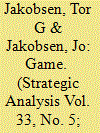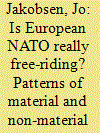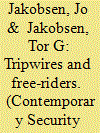| Srl | Item |
| 1 |
ID:
089906


|
|
|
|
|
| Publication |
2009.
|
| Summary/Abstract |
This article employs game theory to explain the 2003 US-led invasion of Iraq, seeking in particular to improve the understanding of why the Iraqi dictator chose a path of action that ultimately led to his downfall. The main argument is that Saddam Hussein lacked information about his opponent's payoffs and was lured by the possibility of becoming the undisputed leading figure of the Arabic world. The analysis shows that even if the threat of an allied attack in the end proved credible, Iraq could - quite rationally - have chosen to stand firm.
|
|
|
|
|
|
|
|
|
|
|
|
|
|
|
|
| 2 |
ID:
162502


|
|
|
|
|
| Summary/Abstract |
Does European NATO free-ride on America? This article uses a mixed-methods approach to explore developments after the Cold War. I investigate both “material” measures, such as military expenditure and troop numbers, and a “non-material” indicator that draws on survey data of the public’s willingness to fight for their country. Results and conclusions are not univocal. On the one hand, European NATO members have generally reduced their military spending (relative to GDP), abolished conscription and downsized their military forces. Their citizens’ self-reported willingness to fight has also been quite low after the Cold War, in particular in states that host US military bases. On the other hand, some of these developments can surely be explained by a decrease in threat perceptions in Europe. Trends changed markedly after Russia’s 2014 annexation of Crimea, which moved many allies – in particular new NATO member states – to increase their defence efforts.
|
|
|
|
|
|
|
|
|
|
|
|
|
|
|
|
| 3 |
ID:
158061


|
|
|
|
|
| Summary/Abstract |
Majority of temporary labour migrants in the Gulf originate in countries that are not involved in devastating armed conflicts. Migrations from conflict-ridden countries to the Gulf are not negligible, however, and they have been growing in the last decades. The overview of migrations from the major refugee-producing countries suggests that we may distinguish between different categories of mixed migrations; inter alia, migrants who migrated to the Gulf prior to, during and after the armed conflicts in their home countries. We argue that these migrations happened in parallel with the tremendous economic growth that the Gulf countries have experienced in the last decades. Of note, however, is that they also coincide with escalations of armed conflicts in several sending countries, which may indicate that some of these migrations are also the result of war- or security-related push forces. We also contend that the dynamics of migrations from countries in conflict may in addition be related to the foreign policies of the Gulf countries, which are often closely related to their treatment of different migrant groups.
|
|
|
|
|
|
|
|
|
|
|
|
|
|
|
|
| 4 |
ID:
166609


|
|
|
|
|
| Summary/Abstract |
This article investigates the relationship between U.S. overseas troops and the willingness of the citizens of host states to fight for their country. The study joins the long-running debate about burden-sharing and free-riding among U.S. allies. Unlike most previous empirical studies, we focus on non-material or intangible measures of the underlying concepts. Our dependent variable estimates the proportion of citizens expressing a willingness to fight for their country. Scores at the aggregate-national as well as the individual level are shaped by the presence of U.S. military forces, which act as a “tripwire” signaling credible security commitments. This increases opportunities of (non-material) free-riding. We present both bivariate and multivariate analyses covering the period 1981–2014 to test this supposition. Findings indicate that once U.S. troop levels reach a certain threshold (between 100 and 500 troops), citizens’ willingness to fight drops significantly. This likely reflects non-material free-riding.
|
|
|
|
|
|
|
|
|
|
|
|
|
|
|
|